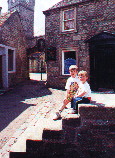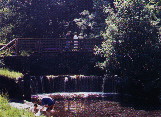|
|
 |
The Parish of EAST KILBRIDE
East Kilbride Subject IndexBibliograhyOLD EAST KILBRIDE The local newspaper is the East Kilbride News Business and CommerceDairyingIn 1947 the Scottish Cooperative Wholesale Society's (SCWS) Creamery in Main Street pasteurised over 7,500 gallons of milk each today. Today there is still a dairy industry in the town run by Wiseman's Dairies, one of the UK's largest dairy companies. EngineeringIn 1947 there were two major engineering employers in
East Kilbride:- The RailwayThe first passenger train drawn by a locomotive arrive in Kilbride on 1st September 1868. A sign at the railway station declared that it was 512 feet above sea level. There has been a census every ten years since 1801, excluding 1941. The latest that is currently available is for 1901 and this is available (for a small fee) on the web from at www.scotlandspeople.gov.uk The 1851 Census 2% sample for East Kilbride can be found here Indexes for the 1851 census of East Kilbride are now available on microfich. More information and prices can be found here. Indexes for the 1861 Census of East Kilbride are now also available for sale on fiche - details of how to purchase them can be found here. Church HistoryThe first Quaker Worship Meeting in Scotland was held in East Kilbride in 1653, led by Alexander Hamilton of Drumbuie. In the early part of the 20th Century the churches in the village were the Old Parish, the West Kirk, Moncrieff Church and St. Bride's. The Parish Church, now the Old Parish Church,
has an ancient history. The present building was constructed
in 1774 and can be found tucked away at the junction of Hunter Street
and Montgomery Street in the Village. A list of the churches in today's large modern town can be found here FolkloreTowards the end of the 18th century, Kilbride was the home of Tibbie the witch o' Kirkton who was reputed to be in league with Auld Nick. Between 1946 until 1948 the author George Orwell was a patient in Hairmyres Hospital while suffering from tuberculosis. While there he wrote part of his novel "1984". The Public Hall, nowadays the Village Theatre, in Maxwell Street, is reputed to be haunted by the ghost of one of the old hallkeepers. It is said that East Kilbride was the only place
where Roman Catholics could throw snowballs at Orange Walk Marches. HistoryThe original name of the village was simply KILBRIDE, with the East being added around 1820 to distinguish it from West Kilbride (in Ayrshire). The 'Kil' in Kilbride comes from the Gaelic work call (or cill) which means a religious cell - which was a feature of the way in which the more monastic Celtic church tended to develop. (Unlike the Roman church which was more diocesan in structure). In Kilbride was the religious cell associated with Bride or Bridget. Close by the village, and now part of the modern town most noted for its railway station and hospital, was Hairmyres. This name could mean the cold, misty, moor (from Har meaning cold, or maar meaning mist and mire meaning bog or moor) or it could a derivation of "hermyres", the limestone on which the hospital is built. In 1640 a new house was built in the village. This house, now called "Rose Mound" and located just off Avondale Avenue, is now the oldest surviving house in the village. The famous Scots playwright James Bridie stayed in "Rose Mound" before going of to live a secluded life on the Isle of Bute. The earliest wedding recorded in the parish was on 20th March 1688 when the Rev. Robert Muir officiated at the marriage of William Paterson of Calderwood to Miss Jean Strang. Before Kilbride had it's own Post Office, the mail was delivered to the village by a one-armed Postman from Rutherglen. The first Post Office in the village was at the corner of Glebe and Hunter Streets, in a thatched cottage which was demolished around 1900. The first telegraph girl was a Margaret Caullay. In 1719 a new public house was built in East Kilbride - the Montgomerie Arms is now the oldest pub in the village. A museum in the village is dedicated to the life and work of the Hunter Brothers, John and William, who were pioneering anatomists and surgeons. A quarrell over recognition, resulted in the brothers having little contact with each other after 1760. In 1772 the Kilbride Cattle Show was started and, by the late 1940's this was the largest one-day cattle show in Scotland, taking place in June in the Show Park. The Show Park is still there, owned by the farming community but also the home for East Kilbride Thistle, a junior league football club. Sport has been a past-time for Kilbride folk for many years, with East Kilbride Golf Club, East Kilbride Bowling Club and East Kilbride & Hairmyres Curling Club all being formed in the period between 1872 and 1900.
Until 1947, East Kilbride was a sleepy, peaceful, rural village of about 2,500 souls; the centre of a large rural parish of 37 square miles with over 125 farms and where farming and agricultural businesses played a large part in the village economy - something of the style of life can be seen at the National Museum of Country Life. On Friday 8th 1947 the first meeting of the East Kilbride Development Corporation was held, which body was tasked with the job of drawing up and executing the plans which were to see the construction of a New Town of East Kilbride, taking overflow population from the City of Glasgow and bringing in new industry to form, what is today, Scotland's 6th largest town with a population of over 71,000. The original village area of East Kilbride is still there and active. Many old features were demolished before the days of "conservation", but many other features remain and it is still possible to get a little of the flavour of East Kilbride's rural days. Something of the modern "New Town" of East Kilbride can be found here. Research SchoolsIn 1907 all children from the village attended East Kilbride Public School (now occupied by the East Kilbride campus of South Lanarkshire College) regardless of whether they were Protestant or Roman Catholic. The only difference between them in those days was that the R.C. children attended school half and hour early for religious studies. LAST UPDATED 6th January 2004- Robert Dixon |

 In Calderglen Country Park can be seen "Dickie's Windmill"
which is more than 100 years old. This was built by William Wilson
Dickie who designed farm machinery which revolutionised agriculture.
In Calderglen Country Park can be seen "Dickie's Windmill"
which is more than 100 years old. This was built by William Wilson
Dickie who designed farm machinery which revolutionised agriculture.